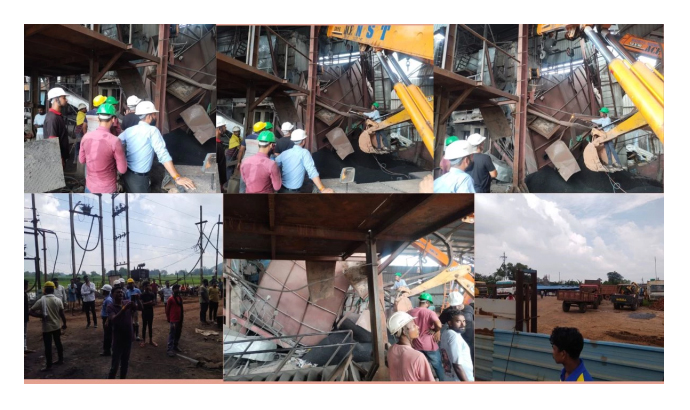Fatal accidents at workplaces are reported every other day. On 8th September, four workers were killed and two others injured at a factory in Chhattisgarh’s Surguja district. The new labour laws will make it even easier for factory owners, employers and management to get away with overlooking and ignoring workers’ safety and social security. While factory owners greed to make extra profit will lead to more fatal accidents, safety of workers’ lives will henceforth be nobody’s responsibility.
Groundxero| September 11, 2024
Factories in India are becoming death traps for workers. Fatal accidents at workplaces are reported every other day. On Sunday (8th September), four workers were killed and two others injured after a hopper filled with coal collapsed on workers at a factory in Chhattisgarh’s Surguja district, where bauxite is refined into alumina.
On the morning of Sunday workers were busy working in the factory as usual. Around 11 o’clock, suddenly, a huge 10 to12 feet high steel tower-mounted hopper filled with burning coal and about 150 feet of belt collapsed, falling onto workers below. A hopper is a type of equipment that is used to transport large quantities of goods from one place to another. Ten workers were trapped when the hopper fell, and 4 were killed, while two others grievously injured.
The deceased workers were identified as Prince Thakur (25) and Manoj Singh Rajput (34), both residents of neighbouring Madhya Pradesh, and Karanveer Manjhi (22), and Ramesnar Manjhi were from Bihar.
Preliminary investigations revealed criminal negligence of the plant management. They were found to be working negligently and carelessly without providing safety equipment to the workers, which resulted in the accident. Sources reveal that earlier the plant’s broiler (belt) was powered by straw. But crushed coal was being used from 1st September. This resulted in the hopper’s collapse due to being overweight. The plant management didn’t upgrade the hooper to bear the excess weight.
Police have registered an FIR against six persons, including the general manager of the plant, under sections 106 (1) (causing death by negligence) and 3(5) (common intention) of the Bharatiya Nyaya Sanhita. But, no arrest has been made in the case so far.
With economic growth and industrial progress, India has witnessed an unfortunate consequence: a disturbing rise in fatal accidents at workplaces. Industrial accidents kill and permanently disable thousands every year. The Union labour minister told Parliament in 2021 that at least 6,500 workers had died while working in factories, ports, mines and construction sites in five years. Out of total industrial casualties, 5629 were reported in factory settings between 2014 and 2018, while 549 were reported from mines, 74 at ports and 237 died at construction sites in central government jurisdiction. In the year 2021, as many as 3,791 workers were injured in factories registered with the government. An estimated one-fourth of these injuries resulted in fatalities.
While as many as 3,331 deaths of workers were recorded between 2018 and 2020; only 14 people were imprisoned for offences under the Factories Act, 1948, during the same period. Recurring events of fatal accidents, which should be called ‘industrial killing’, but in most cases, the ‘killings’ are termed an ‘accidents’ and compensatory justice is advocated for the same. The government itself announces lump-sum compensation to the families of the deceased or injured, shifting focus away from gross negligence and accountability of the owner/management.
The government of India has begun reforming its labour laws to facilitate ‘ease of doing business’ by enacting four new Labour Codes. The Occupational Safety, Health and Working Conditions Code, 2020, essentially replaces the 13 central labour laws relating to safety, health and working conditions at workplaces. Trade union activists and labour-law experts argue that the new law is even less stringent and sets the compliance bar on workers’ safety even lower than the Factories Act, 1948, which currently covers labour welfare and safety.
While the Factories Act, 1948 made it mandatory for all hazardous units, irrespective of size, to form a safety committee, the new code requires a threshold number of 250 workers in hazardous factories or at least 500 workers in a factory to constitute a safety committee.
Currently, labour officers are responsible for inspecting and ensuring the implementation of safety rules, their role will henceforth change to that of mediators under the new codes. Labour Commissioners and Labour Inspectors will be replaced with ‘Facilitators’, who will not have suo motu powers to inspect companies for labour law violations. In case of accidents, the Facilitators will have to inform the management before launching an enquiry, and the investigation report cannot be made public.
So the new labour laws will make it even easier for factory owners, employers and management to get away with overlooking and ignoring workers’ safety and social security. While factory owners greed to make extra profit will lead to more fatal accidents, safety of workers’ lives will henceforth be nobody’s responsibility.


